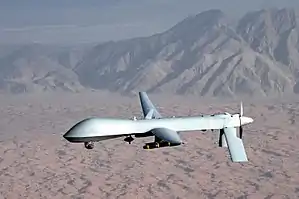Loitering munition
A loitering munition (also known as a suicide drone[1][2][3][4] or kamikaze drone[5][6][7]) is a weapon system category in which the munition loiters around the target area for some time, searches for targets, and attacks once a target is located.[8][9][10] Loitering munitions enable faster reaction times against concealed or hidden targets that emerge for short periods without placing high-value platforms close to the target area, and also allow more selective targeting as the actual attack mission can be aborted.
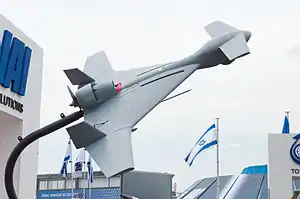
| Part of a series on |
| War |
|---|
Loitering munitions fit in the niche between cruise missiles and unmanned combat aerial vehicles (UCAVs) sharing characteristics with both. They differ from cruise missiles in that they are designed to loiter for a relatively long time around the target area, and from UCAVs in that a loitering munition is intended to be expended in an attack and has a built-in warhead.
Loitering weapons first emerged in the 1980s for use in the Suppression of Enemy Air Defenses (SEAD) role against surface-to-air missiles (SAMs), and were deployed for the SEAD role in a number of military forces in the 1990s. Starting in the 2000s, loitering weapons have been developed for additional roles ranging from relatively long-range strikes and fire support down to tactical, very short range battlefield systems that fit in a backpack.
Loitering munitions have proliferated into use by at least 14 countries, with several different types in use as of 2017. The rising proliferation and the ability to use some systems as lethal autonomous weapons coupled with ethical concerns over such use have led to research and discussion by International humanitarian law scholars and activists.
History
First development and terminology
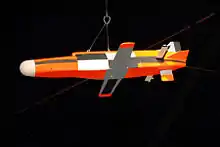
Initially, loitering munitions were not referred to as such but rather as suicide UAVs or loitering missiles. Different sources point at different projects as originating the weapon category. The early 1980s initial Israeli Delilah variants[11][12] or the failed US AGM-136 Tacit Rainbow program[13][14] are mentioned by some sources. Alternatively, the late 1980s IAI Harpy which was widely exported is considered by some as the first loitering munition system.[15]

Early projects did not use the "loitering munition" nomenclature which emerged at a much later date, and used existing terminology at the time. For instance the AGM-136 Tacit Rainbow was described as follows in a 1988 Air Force Magazine article:
the Tacit Rainbow unmanned jet aircraft being developed by Northrop to loiter on high and then swoop down on enemy radars could be called a UAV, a cruise missile, or even a standoff weapon. But it is most definitely not an RPV.
Initial role in suppression of enemy air defense

The response to the first generation of fixed installation surface-to-air missiles (SAMs) such as S-75 and S-125 was the development of the anti-radiation missile such as AGM-45 Shrike and other means to attack fixed SAM installations, as well as developing SEAD doctrines. The Soviet counter-response was the use of mobile SAMs such as 2K12 Kub with intermittent use of radar.[16] Thus, the SAM battery was only visible for a small period of time, during which it was also a significant threat to high-value Wild Weasel fighters. In 1982 Operation Mole Cricket 19 various means including UAVs and air-launched Samson decoys were used over suspected SAM areas to saturate enemy SAMs and to bait them to activate their radar systems, which were then attacked by anti-radiation missiles.[17][18]
In the 1980s, a number of programs, such as the IAI Harpy or the AGM-136 Tacit Rainbow, integrated anti-radiation sensors into a drone or missile air frames coupled with command and control and loitering capabilities. This allowed the attacking force to place relatively cheap munitions in place over suspected SAM sites, and to attack promptly the moment the SAM battery is visible. This integrated the use of a drone as a baiting decoy with the attack role into one small and relatively cheap platform in comparison to the alternative wild weasel jet fighter.[19][20][21][22]
Evolution into additional roles
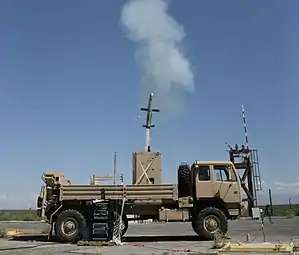
Starting in the 2000s, loitering weapons have been developed for additional roles beyond the initial SEAD role ranging from relatively long-range strikes and fire support[23] down to tactical, very short-range battlefield use such as the AeroVironment Switchblade which is deployed at the platoon level and fits in a backpack.[24][25][26][27] A documented use of loitering munitions was in 2016 Nagorno-Karabakh clashes in which an IAI Harop was used against a bus functioning as a troop transport.[7]
Characteristics

Loitering munitions may be as simple as an unmanned aerial vehicle (UAV) with attached explosives that is sent on a potential kamikaze mission, and may even be constructed with off the shelf commercial quadcopters with strapped on explosives.[28]
Purpose built munitions are more elaborate in flight and control capabilities, warhead size and design, and on-board sensors for locating targets.[29] Some loitering munitions use a human operator to locate targets whereas others, such as IAI Harop, can function autonomously searching and launching attacks without human intervention.[30][31]
Some loitering munitions may return and be recovered by the operator if they are unused in an attack and have enough fuel; in particular this is characteristic of UAVs with a secondary explosive capability.[32] Other systems, such as Delilah[11][33] or IAI Harop,[10] don't have a recovery option and are self-destructed in mission aborts.
Comparison to similar weapons
Loitering munitions fit in the niche between cruise missiles and unmanned combat aerial vehicles (UCAVs).[10][34]
The following table compares similar size-class cruise missiles, loitering munitions, and UCAVS:
| Characteristic | Cruise missile | Loitering munition | UCAV |
|---|---|---|---|
| Cost appropriate for expendable one-time use | Yes | Yes | No, but high cost allows for higher-quality platform |
| Recovery possible after launch | No | Usually no | Yes, typical mission profile is round-trip |
| Built-in warhead | Yes | Yes | No |
| Stealthy final dive to target | Usually yes | Usually yes | Usually no |
| Loitering | No or limited | Yes | Usually yes |
| Sensors for target acquisition | Limited | Yes | Usually yes |
| Command and control during flight | Usually limited | Yes | Yes |
| Range | Longer, optimized for constant speed flight | Shorter | Shorter, even shorter for typical round-trip mission |
| Speed | Typically higher | Typically lower | Depends on role |
| Example type | 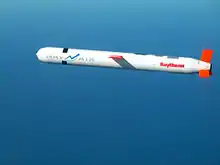 Block IV Tomahawk cruise missile. Small wing area is optimized for high-speed cruise. |  IAI Harop a loitering munition optimized for the Suppression of Enemy Air Defenses (SEAD) role | |
| Range | 1,600 km | 1,000 km | 1,100 km |
| Max speed | high sub-sonic, 880 km/h | 190 km/h | 217 km/h |
| Flight endurance | c. 2 hours | 6 hours | 24 hours |
| Engine | 3.1 kilonewtons (700 lbf) F107-WR-402 turbofan engine | 37 hp Wankel engine | 115 hp Rotax 914F |
| Loaded system weight | 1,588 kg | 135 kg | 1,020 kg |
| Payload | 450 kg warhead | 23 kg warhead | 2 × AGM-114 Hellfire or 6 × AGM-176 Griffin air-to-surface missiles |
| Length | 6.25 m | 2.5 m | 8.22 m |
| Wingspan | 2.67 m [35] | 3.0 m [29] | 16.8 m [36] |
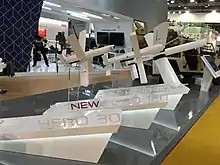
Whereas some cruise missiles, such as the block IV Tomahawk, have the ability to loiter and have some sensory and remote control features,[37] their primary mission is typically strike and not target acquisition. Cruise missiles, as their name implies, are optimized for long-range flight at constant speed both in terms of propulsion systems and wings or lifting body design. They are often unable to loiter at slow fuel-efficient speeds which significantly reduces potential loiter time even when the missile has some loiter capabilities.[38]
Conversely almost any UAV could be piloted to crash onto a target and most could be fitted with an improvised explosive warhead.[28] However the primary use of a UAV or UCAV would be for recoverable flight operations carrying reconnaissance equipment and/or munitions. While many UAVs are explicitly designed with loitering in mind, they are not optimized for a diving attack, often lacking forward facing cameras, lacking in control response-speed which is unneeded in regular UAV flight, and are noisy when diving, potentially providing warning to the target. UAV's, being designed as multi-use platforms, often have a unit cost that is not appropriate for regular one-time expendable mission use.[39][34]
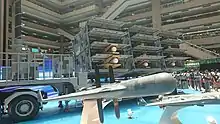
The primary mission of a loitering munition is reaching the suspected target area, target acquisition during a loitering phase, followed by a self-destructive strike, and the munition is optimized in this regard in terms of characteristics (e.g. very short engine life time, silence in strike phase, speed of strike dive, optimization toward loitering time instead of range/speed) and unit cost (appropriate for a one-off strike mission).[40][41]
Ethical and international humanitarian law concerns
Loitering munitions that are capable of making autonomous attack decisions (man out of the loop) raise moral, ethical, and international humanitarian law concerns because a human being is not involved in making the actual decision to attack and potentially kill humans, as is the case with fire-and-forget missiles in common use since the 1960s. Whereas some guided munitions may lock-on after launch or may be sensor fuzed, their flight time is typically limited and a human launches them at an area where enemy activity is strongly suspected, as is the case with modern fire-and-forget missiles and airstrike planning. An autonomous loitering munition, on the other hand, may be launched at an area where enemy activity is only probable, and loiter searching autonomously for targets for potentially hours following the initial launch decision, though it may be able to request final authorization for an attack from a human. The IAI Harpy and IAI Harop are frequently cited in the relevant literature as they set a precedent for an aerial system (though not necessarily a precedent when comparing to a modern naval mine) in terms of length and quality of autonomous function, in relation to a cruise missile for example.[42][43][44][45][46][47]
Users and producers
As of 2020, loitering munitions are in use in several countries, including:
 Armenia - domestically produced HRESH, BEEB 1800[48]
Armenia - domestically produced HRESH, BEEB 1800[48] Artsakh[49]
Artsakh[49] Azerbaijan - IAI Harpy, IAI Harop, Orbiter 1K,[7] STM Kargu[50][51]
Azerbaijan - IAI Harpy, IAI Harop, Orbiter 1K,[7] STM Kargu[50][51] China - IAI Harpy, CH-901, WS-43, ASN-301[52][53]
China - IAI Harpy, CH-901, WS-43, ASN-301[52][53] Germany,[54]
Germany,[54] India - IAI Harpy,IAI Harop.[55][56]
India - IAI Harpy,IAI Harop.[55][56] Iran - Qasef-1, Raad 85 (UAV), and possibly others[57][58][59]
Iran - Qasef-1, Raad 85 (UAV), and possibly others[57][58][59] Islamic State of Iraq and the Levant - organized program of acquiring commercial drones, and improvising them for loitering munition role[28][60][61]
Islamic State of Iraq and the Levant - organized program of acquiring commercial drones, and improvising them for loitering munition role[28][60][61] Israel - IAI Harpy, IAI Harop, IAI Green Dragon, IAI Rotem L, Aeronautics Defense Orbiter, Delilah, SkyStriker.[62] Indigenous manufacture of additional types by Israel Aerospace Industries,[63] UVision,[64][65] Aeronautics Defense,[66] Elbit Systems,[67] and Israel Military Industries[68]
Israel - IAI Harpy, IAI Harop, IAI Green Dragon, IAI Rotem L, Aeronautics Defense Orbiter, Delilah, SkyStriker.[62] Indigenous manufacture of additional types by Israel Aerospace Industries,[63] UVision,[64][65] Aeronautics Defense,[66] Elbit Systems,[67] and Israel Military Industries[68] Kazakhstan,[4]
Kazakhstan,[4] Poland - WB Electronics Warmate[69]
Poland - WB Electronics Warmate[69] South Korea - Devil Killer,[70][71] IAI Harpy
South Korea - Devil Killer,[70][71] IAI Harpy Taiwan - NCSIST Chien Hsiang,[72] NCSIST Fire Cardinal
Taiwan - NCSIST Chien Hsiang,[72] NCSIST Fire Cardinal Turkey - STM Kargu,[73] STM Alpagu, IAI Harpy[74]
Turkey - STM Kargu,[73] STM Alpagu, IAI Harpy[74] United States - AeroVironment Switchblade, Raytheon Coyote[75]
United States - AeroVironment Switchblade, Raytheon Coyote[75] Uzbekistan[4] - IAI Harpy, IAI Harop
Uzbekistan[4] - IAI Harpy, IAI Harop Yemen - Houthis Rebels - Qasef-1[76]
Yemen - Houthis Rebels - Qasef-1[76]
See also
References
- US army may soon use Israeli-designed ‘suicide drones’, Jerusalem Post, June 2016
- China Unveils a Harpy-Type Loitering Munition, Israel Defense, March 2017
- Meet Israel’s ‘Suicide Squad’ of Self-Sacrificing Drones, The Drive, August 2016
- Loitering Munitions - In Focus, Center for the Study of the Drone, Feb 2017
- Kamikaze drone loiters above, waits for target, CNET, June 2009
- 'Kamikaze drones' add a new layer of lethality to remote force, C4ISRNET, August 2015
- Israeli-made kamikaze drone spotted in Nagorno-Karabakh conflict, Washington Post, April 2016
- Loitering Munition Availability Expanding Internationally, Aviation Week, April 2016
- Loitering Weapon Systems – A Growing Demand, h-ils, December 2016
- Watch This Drone Turn Into A Missile, Popular Science, August 2015
- The Secrets of Delialah (Hebrew), IAF bulletin, issue 184, December 2008
- Loitering Weapons are making a Comeback, Defense Update, June 2009
- An Introduction to Autonomy in Weapon Systems, pages 13-14, By: Paul Scharre and Michael C. Horowitz, CNAS Working paper, Feb 2015
- Canan, James W. "Unmanned Aerial Vehicles." Air Force Magazine (1988)., page 87
- Drone Strike!: UCAVs and Aerial Warfare in the 21st Century, By Bill Yenne, ISBN 9781580072526, pages 106-107
- Reedy, Edward K. (1 January 1987). "Radar ECCM Considerations and Techniques". In Eaves, Jerry L.; Reedy, Edward K. (eds.). Principles of Modern Radar. Springer US. pp. 681–699. doi:10.1007/978-1-4613-1971-9_22. ISBN 978-1-4612-9170-1.
- Six Days in June (Hebrew), IAF bulletin, issue 145, June 2002
- Surface to Air Missile Effectiveness in Past Conflicts, Technical Report APA-TR-2010-1001, Dr Carlo Kopp, AFAIAA, SMIEEE, PEng, October 2010
- Meet Israel's 'Suicide Squad' of Self-Sacrificing Drones, August 2016, The Drive
- ADAPTIVE DISCRETE EVENT SIMULATION FOR ANALYSIS OF HARPY SWARM ATTACK, Brandon J. Cobb, Naval Postgraduate School, Thesis, September 2011
- "Suminsby, Robert E. Fear no Evil: Unmanned combat air vehicles for suppression of enemy air defenses. AIR UNIV MAXWELL AFB AL AEROSPACE STUDIES INST, 2002".
- Loitering, Smart Cruise Missile Marketed to U.S. Navy, National Defense, June 2001
- British Army Sets to Deploy Fire Shadow Loitering Weapons to Afghanistan by Early 2012 Defense Update, September 2011
- Military Investigates Killer Drones That Can Fit in Rucksacks National Defense, July 2011
- A Tiny Missile That Waits Overhead—Silent, Patient and Deadly, WarIsBoring, January 2014
- AeroVironment producing Switchblade missiles for Army UPI, October 2016
- Loitering Autonomous Weapons Archived 2013-02-05 at the Wayback Machine, Defense Update, January 2007
- ISIS Using Kamikaze Drones in Iraq, Popular Mechanics, October 2016
- iClean – Loitering Attack UCAV, Artzi Dror, Technion Institute of Technology, 2012
- Israel Unveils Loitering Anti-Missile Drone Archived 2018-03-15 at the Wayback Machine, Defense Update, 2009
- Harpy Air Defense Suppression System, Defense Update, 2006
- IAI's ROTEM – Tactical Multirotor Killer Drone, Defense Update, 2016
- Delilah – The IAF Loitering Missile, Defense Update, June 2009
- Gilli, Andrea, and Mauro Gilli. "The Diffusion of Drone Warfare? Industrial, Organizational and Infrastructural Constraints: Military Innovations and the Ecosystem Challenge." (2015)., pages 21–22, 25–31
- RGM/UGM-109 Tomahawk, fi-aeroweb, November 2014
- MQ-1B Predator factsheet, US Air Force, July 2010
- The U.S. Navy Has Big Plans for the Lethal Tomahawk Missile, The National Interest, Kris Osborn, 18th May 2016
- Takahashi, Timothy, et al. "A multi-disciplinary survey of advanced subsonic tactical cruise missile configurations." 43rd AIAA Aerospace Sciences Meeting and Exhibit. 2005.
- "Franklin, Michael. "Unmanned combat air vehicles: opportunities for the guided weapons industry?." RUSI Occasional Paper, www. rusi. org/downloads/assets/Unmanned_Combat_Air_Vehicles. pdf (29.3. 2011) (2008)" (PDF). RUSI.org. Retrieved 15 June 2017.
- "Liu, Xuancen, et al. "Optimal Design of Loitering Munition Trajectory in Complex Battlefield Environment." (2016)". Atlantis Press.
- Snyder, Derek J. (25 April 2017). "Design Requirements for Weaponizing Man-Portable UAS in Support of Counter-Sniper Operations" – via Defense Technical Information Center.
- Garcia, Denise. "Killer robots: Why the US should lead the ban." Global Policy 6.1 (2015): 57–63.
- Sharkey, Noel. "Saying 'no!' to lethal autonomous targeting." Journal of Military Ethics 9.4 (2010): 369–383.
- "Mortensen, Erika Steinholt. Autonomous weapon systems that decide whom to kill. How international humanitarian law and international human rights law regulate the development and use of offensive autonomous weapon systems during international armed conflicts. MS thesis. UiT Norges arktiske universitet, 2016" (PDF).
- Alston, Philip. "Lethal robotic technologies: the implications for human rights and international humanitarian law." JL Inf. & Sci. 21 (2011): 35.
- "Crootof, Rebecca. "The Varied Law of Autonomous Weapon Systems." (2015)" (PDF).
- Evan Wallach and Erik Thomas (2016). "The Economic Calculus of Fielding Autonomous Fighting Vehicles Compliant with the Laws of Armed Conflict" (PDF). Yale Journal of Law & Technology. 18: 1–25.
- "Armenian manufacturer boasts cutting-edge multifunctional combat UAVs and loitering munitions". armenpress.am. Retrieved 2020-07-19.
- "Artsakh to mass produce combat drones, trials successfully completed". Public Radio of Armenia. Retrieved 2020-07-19.
- "STM'nin yerli kamikaze İHA'sı KARGU Azerbaycan'da görüldü" (in Turkish). 29 October 2020.
- "İlk kez Libya'da kullanılmıştı! Bu kez Azerbaycan'da görüntülendi" (in Turkish). CNN Türk. 28 September 2020.
- DSA 2016: China details CH-901 UAV and loitering munition, Janes, April 2016
- IDEX 2017: CATIC reveals details about Harpy-type loitering munition, Janes, March 2017
- Germany signs contract for Harop loitering munition, FlightGlobal, September 2009
- Harop Loitering Munitions System for the IAF, India Defence Review, January 2014
- "Laser weapons, swarm drones on DRDO menu". The Hindu. Special Correspondent. 2019-08-12. ISSN 0971-751X. Retrieved 2020-08-11.CS1 maint: others (link)
- Iran's navy touts 'suicide drone', USA Today, October 2016
- Iran Tests 'Kamikaze' Suicide Drone, The National Interest, December 2014
- Iranian army tests home-made suicide drone, Trend news agency, December 2016
- Papers Offer a Peek at ISIS' Drones, Lethal and Largely Off-the-Shelf, New York Times, January 2017
- Portable Attack Drones or Loitering Munitions, SP'S Landforces, September 2016
- Elbit announces new SkyStriker loitering munition Yaakov Lappin, Tel Aviv - IHS Jane's Defence Weekly 08 September 2016
- SINGAPORE: IAI reveals new family of loitering munitions, FlightGlobal, February 2016
- UVision loitering munitions to undergo anti-tank testing, Flight Global, April 2016
- Israeli companies pitching loitering munitions for US Army programme, FlightGlobal, April 2016
- Aeronautics introduces Orbiter 1K loitering munition, FlightGlobal, May 2015
- Elbit announces new SkyStriker loitering munition, Jane's Defence Weekly, September 2016
- Vietnam Eyes Israel's Delilah Standoff Missile, and F-16s Could Be Next, The Warzone, March 2017
- Warmate expendable UAV in production for two customers, Flight Global, April 2016
- South Korea's Kamikaze UAV Could Scare the Ojom Out of Kim Jong-un, Gizmodo, October 2012
- South Korea developing 'kamikaze' attack drone, Fox News, October 2012
- Wong, Kelvin. "TADTE 2019: Taiwan's NCSIST rolls out indigenous anti-radiation loitering munition". www.janes.com. Janes. Retrieved 21 October 2019.
- "Turkey's STM delivering Kargu loitering munitions to TSK | Jane's 360". www.janes.com. Retrieved 2020-03-23.
- IAI Gets $100 Million Contract for HAROP Killer Drones, Defense Update, 2009
- Surface Navy 2017: Coyote earmarked for ISR and offensive roles, Janes, January 2017
- Suicide Drones Have Migrated To The Conflict In Yemen, The Warzone, March 2017
